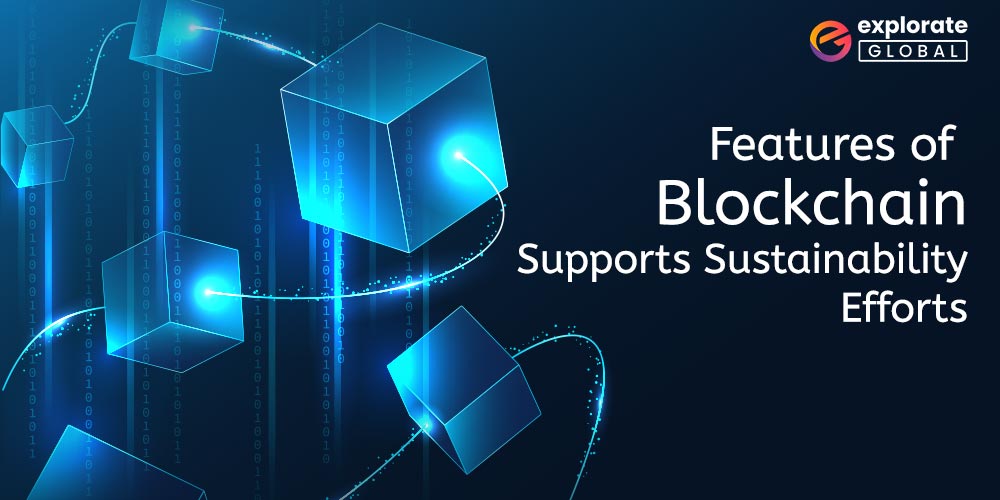
As we strive to lessen our influence on the environment, sustainability has grown in importance for both businesses and individuals. While there are numerous aspects to take into consideration when it comes to sustainability, Blockchain technology is one area that is gaining popularity.
Businesses all throughout the world commit to sustainable initiatives or practices that are adaptive, long-lasting, and have no negative environmental effects.
Blockchain technology can increase an organization’s energy efficiency and lower its overall computing costs. With the help of blockchain and its distinctive properties, our current and future sustainability activities are protected.
How can Features of Blockchain Support Sustainability Efforts?
Although blockchain is best recognized as the innovative technology that underlies cryptocurrencies, it has much more to its name. It can work marvels if used properly. Let us discuss some of such marvels.
Stimulates health and well-being
To provide remote healthcare to those in need and maintain the privacy of their records, the healthcare industry needs blockchain assistance.
However, Blockchain, IoT, and AI together can support a WHO-approved cooperation platform. People can select active lives and control interactive communities thanks to blockchain-based health and wellness.
Helps in balancing the food industry
In order to handle hunger relief, blockchain can cut costs for businesses, increase accuracy, and offer responsibility. Also, in order to stop food waste and unjust resource distribution, blockchain can redesign the supply network and patch any leaks in the flow.
With better resource management, this program can address the challenge of rising food prices and can end hunger.
Third-world nations are having a difficult time managing supply chain issues. So for this, green technology businesses can provide long-term channels for suppliers while reducing the costs of intermediaries. The majority of consumers’ purchasing power will improve as a result, and there won’t be any food waste.
Helps in energy management
Rising gas and energy costs have alarmed customers on all scales. Blockchain has a huge potential to increase efficiency and reduce costs in the production of renewable energy.
Reduced dependency on crude oil will result from the implementation of blockchain renewable energy sources. This industry is expanding significantly to facilitate the widespread adoption of sustainable initiatives.
Helps in improving the education sector
The largest issue in the educational field is plagiarism. Blockchain is renowned for its security, privacy, and integrity and has the ability to encrypt all individuals’ data.
Education institutions can employ blockchain technology’s top feature, immutability, to verify students and reduce the wait time for admission from weeks to minutes.
The blockchain-based educational system will support sustainability and openness, ease concerns about plagiarism, and pave the path for online and distance learning.
Also know: How Does Blockchain Support Data Privacy
Major Features of Blockchain Technology
Below are the major features that contribute to and support the sustainability of efforts.
Decentralized
As a decentralized network, the Blockchain lacks a central authority to oversee the infrastructure. Instead, a group of nodes, also known as miners, dispersed throughout the globe manages the network’s security and integrity.
This is one of the key characteristics of the blockchain that enables ensuring trust in the data acquired. In fact, changing the information on the ledger requires a sizable majority of nodes to agree to do so simultaneously.
A sufficiently decentralized network of blockchain miners makes it highly improbable that anything will change. In other words, decentralization ensures that no single party can control or alter the information on the ledger, which improves network security.
It is Immutable
Immutability refers to the inability to change anything. Due to the technology’s unchanging nature, this characteristic makes sure that it is trustable.
Banking systems and blockchain technology operate in distinct ways. Blockchain technology uses encryption to ensure that the information on its ledger is authentic and reliable rather than relying on centralized and reliable authorities.
The digital ledger has a copy on each node. Every node verifies its legitimacy before adding transactions. The majority of nodes must agree that the transactions are legitimate and valid before they can be put into the ledger.
A block cannot be changed once it is recorded in the distributed ledger. This promotes openness and obviates any chance of corruption.
Distributed Ledger
All of the machines that are a member of the blockchain mining network receive access to the ledger.
The majority of the blockchains that are at present usable are open. A public ledger contains details about a transaction and the people involved. Therefore, everyone has access to the transactions and information kept on a public blockchain.
Also, there are privacy blockchains where the data kept on the distributed ledger is hidden from the general public but may be accessed with a unique viewing key. That key is only available to wallet owners.
As a result, anyone with the appropriate viewing key can access the transactions of a certain account or simply the information related to a particular transaction.
It possesses a Consensus Algorithm
Consensus algorithms are the reason why blockchains succeed. The consensus algorithm is a major component of the architecture, which is creatively designed. Blockchains can preserve the accuracy and reliability of the data they record thanks to consensus procedures.
For the network’s active nodes, the consensus serves as the primary decision-making mechanism. The nodes can now agree immediately and substantially faster.
The system needs consensus, particularly when nodes are validating transactions. This makes it possibly the most significant blockchain feature.
So, up till now, you must have become well-known with different Blockchain features, let us move forward and understand why and how features of blockchain support sustainability efforts.
Also know: How To Build A Crypto Trading Bot
Conclusion
To conclude, in this article, we have explained how can features of blockchain support sustainability efforts. Through all the aforementioned points, it is evident that in addition to financial gains, Blockchain promotes sustainability.
If you want to add some more features of blockchain or wish to share any thoughts on Blockchain for sustainability, connect with us in the comments section below!

